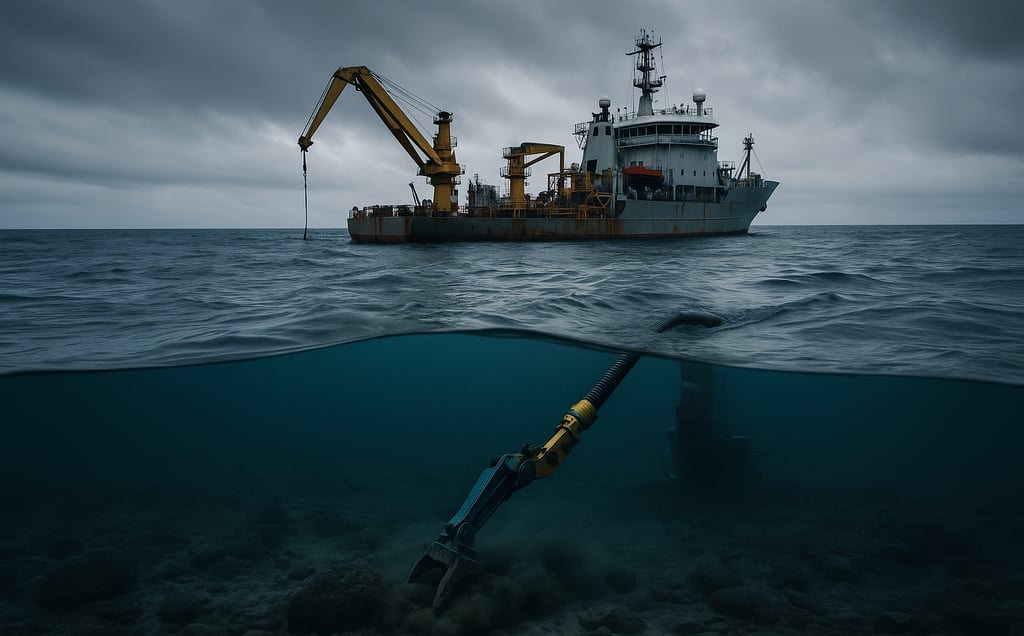In the waters of Namibia, marine diamonds surface: at what price?
AFRICA
Thomas Bonnamy
7/26/20255 min read


Far from the scorching deserts and images of open-pit mines, another reality of African diamond mining emerges off the coast of Namibia. For several decades, the seabed of the south Atlantic has been home to a singular industry: the extraction of underwater diamonds. Today, Namibia is the only country in the world to have industrialized this activity, following a partnership between the Namibian State and unique companies. Giant robots, operating at a depth of more than 100 meters, probe the ocean floor to collect the coveted precious stones. But this technological and economic success also raises questions, notably ecological, political and ethical. Is Namibia laying the foundation for a thriving new industry, or entering an environmental impasse?
A PIONEERING SUBMARINE INDUSTRY, RESULTING FROM AN EXCEPTIONAL COASTAL DEPOSIT
It all begins on the beaches of Namibia, at the southern border of the Namib Desert. For more than a century, these sandy shores have been teeming with diamonds transported by the Orange River from the interior of the African continent. Erosion gradually carried these gems to the Atlantic Ocean, where the currents deposited them on the seabed. In the 1960s, geologists discovered significant concentrations of diamonds no longer on the coast, but in the shallow waters of the continental shelf. In 1991, the Namibian State and the South African company "De Beers" founded "Namdeb", then "Debmarine", specializing in underwater extraction. Today, more than 70% of Namibian diamonds come from the sea. The operating area extends over nearly 6,000 km 2, along a desert coastline of 300 kilometers. Factory ships, real floating platforms, operate day and night using suction or hydraulic cutting systems. In 2022, the ship 'Benguela Gem', the most advanced of the fleet, enters into service. It can extract up to 500,000 carats per year. These diamonds, considered the purest in the world, represent a major strategic resource for Namibia, the second source of income after fishing. But their extraction is not without consequences.
A PUBLIC-PRIVATE GOVERNANCE, BETWEEN AUTONOMY AND DEPENDENCE
The originality of the Namibian model is based on its mixed governance. “Debmarine Namibia” is owned equally by the Namibian government and De Beers, itself majority-controlled by the Anglo-Australian giant Anglo American. The State thus has a right of oversight over operations and a direct return on profits. This structure has allowed Namibia to retain partial sovereignty over its resource, while relying on the technological know-how of its private partners. In 2022, 'Debmarine' paid more than N$2 billion (around €100 million) to the state, in the form of dividends, taxes and royalties. Operations are subject to strict permits, issued by the Ministry of Mines and Energy, and subject to environmental assessments. Independent scientific teams regularly monitor the evolution of affected marine ecosystems. In theory, the operated sites are then 'rehabilitated', that is to say leveled and stabilized. But in practice, the data remains largely controlled by the operator himself, and experts warn about the lack of transparency of long-term impacts.
POORLY KNOWN, BUT POTENTIALLY MAJOR ECOLOGICAL IMPACTS
The extraction of marine diamonds profoundly modifies the ocean floor. The dredges suck up the sand several meters thick, destroying habitats and microfauna. Resuspended sediments can stretch for miles, asphyxiating filter-feeding organisms. Unlike land-based operations, these damages are invisible to the general public because they are located away from prying eyes. While the studies commissioned by Debmarine generally conclude in a "rapid recolonization", other academic research is more cautious: they highlight the scarcity of data on endemic species of the Namibian continental shelf and uncertainties about long-term cumulative effects. To this is added a broader question about the precedent that this industry creates. Namibia is today a full-scale laboratory for ocean mining, at a time when the deep sea seabeds fuel covetousness. Several countries and companies are already planning to extract rare metals from the abyss, in the name of energy transition. Proponents of deep sea mining often cite Debmarine as an example of technical feasibility. But this comparison is misleading: the Namibian waters are coastal, shallow and already subject to industrial uses. The leap to the open sea, even more fragile and unknown, poses unparalleled ethical and ecological challenges.
BETWEEN ECONOMIC SUCCESS AND RISKS OF STRUCTURAL DEPENDENCE
From an economic point of view, the Namibian model seems to work. Revenue generated from diamonds has contributed to the development of infrastructure, the creation of skilled jobs (notably in logistics and marine robotics), and the improvement of macroeconomic indicators. Namibia has one of the most stable growth rates on the continent, with a relatively strong currency (the Namibian dollar is pegged to the South African rand). Yet this success hides a strong dependence on a single sector, in a country of only 2.6 million inhabitants. The risks are multiple: drop in diamond prices, tensions in the partnership with De Beers, effects of depletion of deposits. In the medium term, some experts believe that current marine deposits could be fully exploited by 2040. The country will then have to turn towards deeper, more expensive and riskier deposits, or diversify its economy. Moreover, the diamond manna does not benefit equally the entire population: inequalities remain high, particularly between urban and rural areas, and youth unemployment exceeds 30%.
A MODEL ON THE SURFACE, A COMPLEXITY IN DEPTH
The Namibian example is often presented as a model of responsible mining in developing countries. Its clear legal framework, shared governance, measurable economic impact and technical expertise have earned it the praise of many institutions. But this exemplarity remains relative. On the one hand, because it is based on specific conditions: a small population, a relatively stable state, competent public institutions, limited social pressure, and an already little exploited marine environment. On the other hand, because the ecological and social impacts, although better monitored than elsewhere, remain partly opaque. In other contexts, transposition would be difficult. In West Africa, for example, where marine waters are already overexploited by illegal fishing, institutions are fragile and governance of extractive industries suffers from corruption, the very idea of undersea mining seems premature. On the other hand, technologically advanced countries such as Norway or Japan are studying their own projects, but they remain hindered by critics from civil society and researchers.
A WARNING FOR THE FUTURE OF THE OCEANS
Finally, the exploitation of underwater diamonds in Namibia illustrates both the promises and the perils of a new extractive frontier. It shows that complex technologies can work, that public-private partnerships can be balanced, and that marine resources can generate significant revenues. But she also reminds us that any extraction, even if supervised, profoundly modifies ecosystems, and that the data on the real impact of these operations remain fragmentary. At a time when international negotiations on the protection of the high seas are progressing, the Namibian case must be studied with rigor and caution. It embodies less a universal model than an alarm signal: that of a world where the pressure on the oceans is intensifying, at the risk of moving unresolved dilemmas of our dependence on natural resources to the depths.
Thomas Bonnamy, for SPECTIO
The opinions expressed are those of the authors and do not reflect the position of Think Tank Spectio.
